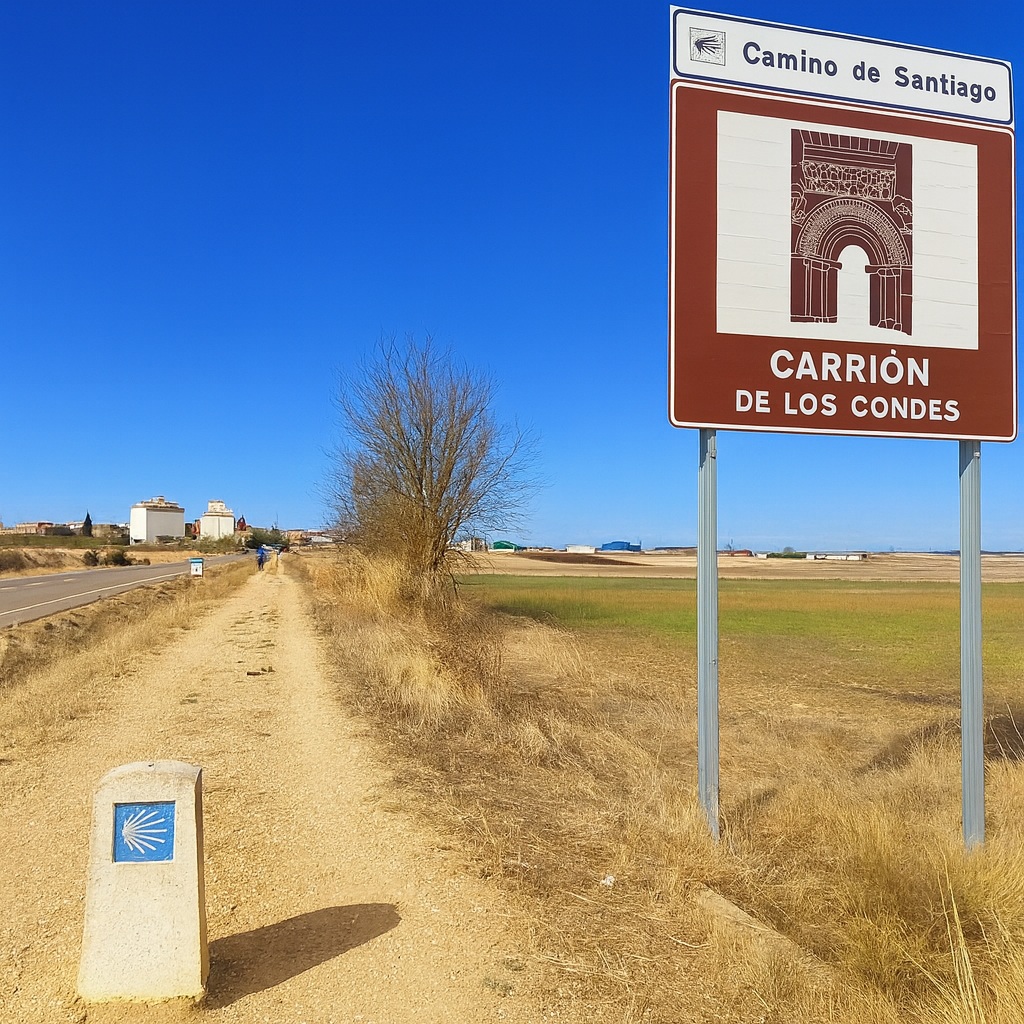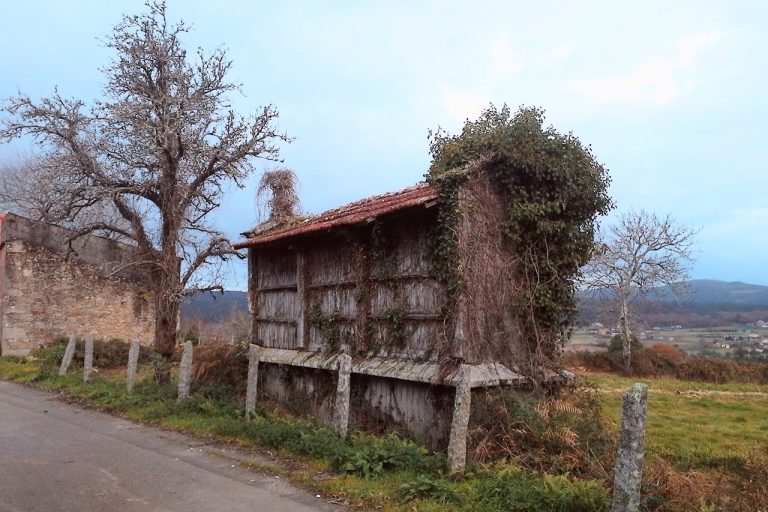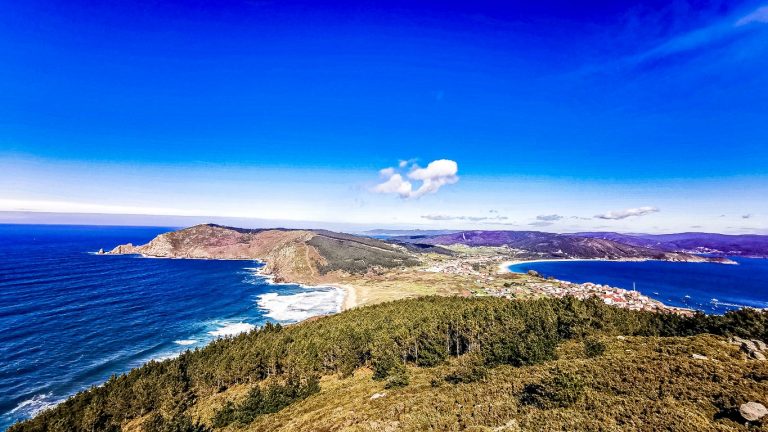
A New Stage Day – Introduction & Mood
The morning in Frómista begins with a quiet magic. In front of the Romanesque church of San Martín de Tours, the first pilgrims gather, the light of the rising sun painting bright contours on the clear round arches. The memory of yesterday’s finale at the Canal de Castilla still lingers as you set out from the town. Today the way promises less drama, but instead peace – a stage for breathing, for listening within yourself.
Behind you lie the ascent and descent of the Alto de Mostelares; today the plain opens up. The paths are flat, the horizons wide, and usually a gentle wind blows. It is a stage that neither physically challenges nor surprises you – but precisely because of this, it offers the opportunity to move forward inwardly.
Route & Elevation Profile
- Distance: approx. 19 km
- Elevation gain/loss: ±100–150 m
- Difficulty: easy – one of the more relaxing stages, ideal for recovery.
The paths are mostly flat, small rises and drops smooth the course. Compared to yesterday’s climb at the Alto de Mostelares, this stage is a balance – like a deep breath before new challenges await.









Variants & Small Detours
In Población de Campos, the Camino splits:
- Left variant: runs along the Río Ucieza – a quieter, more natural route, often chosen by pilgrims who seek the closeness of water and seclusion.
- Right variant: stays on the historic route through Villovieco, with old churches and small houses – somewhat livelier, more contact with the villages.
Both ways reunite later in Villalcázar de Sirga, where the mighty church of Santa María la Blanca welcomes the pilgrim.
Description of the Way – With All Senses
You leave Frómista on a straight path, accompanied by the noise of the country road, but soon only fields and sky surround you. The Camino stretches like a quiet ribbon through the plain. The sun rises higher, the wind stirs the grain, and the simplicity of the way begins to take effect.
In Población de Campos the choice opens: left by the Río Ucieza or right through Villovieco. To the left, the splashing of water accompanies you, reeds sway in the wind, birds circle above. To the right, you meet the people, their churches, their history. Both paths have their value, and the Camino lets you freely choose.
Behind the reunion in Villalcázar de Sirga, a surprise rises: the church of Santa María la Blanca, a mighty building of the Templar Order. Already from afar you see its massive walls, which, in contrast to the simplicity of the landscape, appear almost awe-inspiring. Inside, it holds precious Gothic tombs and a deep silence – a place where history and spirituality are interwoven.
From here it is only a few more kilometers to Carrión de los Condes, a lively town full of pilgrim tradition. You enter it over a bridge and are welcomed by monasteries, churches, and the friendly bustle of a town that has hosted pilgrims for centuries.
Intermediate Villages & Special Features
| Place | Distance from Frómista | Special feature |
| Población de Campos | approx. 4 km | Path splits here – left river variant or right historic route |
| Villovieco (right var.) | approx. 8 km | Small village with Romanesque church |
| Villalcázar de Sirga | approx. 13 km | Templar church Santa María la Blanca – mighty Gothic pilgrimage sanctuary |
| Carrión de los Condes | 19 km | Monasteries, churches, long pilgrim tradition |
Packing & Shopping Tips
- Short stage: no large supplies needed, but water and a small snack are advisable.
- Freedom of choice: Consider in Población de Campos whether you seek quiet by the river or life in the village.
- Villalcázar de Sirga: A worthwhile stop for those interested in culture – plan time for the church.
Food, Accommodation & Supplies
Carrión de los Condes is a traditional pilgrim town with many albergues, hotels, and monastic accommodations. Especially the monastery of San Zoilo is a highlight: pilgrims can stay here in the former Benedictine monastery and admire the cloisters full of sculptures.
Villalcázar de Sirga also offers albergues and bars – an ideal resting point if you wish to shorten the stage.
Today’s Special Features
The church of Santa María la Blanca in Villalcázar de Sirga is the shining highlight of the day. Built by the Templars, it appears from the outside like a fortress and from the inside like a treasury of faith. Pilgrims, kings, and knights have prayed here, and even today a special atmosphere envelops you as you enter.
At the same time, the stage itself is a gift: after the exertions of the past days, it allows rest and reflection. Walking becomes meditation, the steady rhythm a prayer.
Reflection at the End of the Stage
When you arrive in Carrión de los Condes in the evening, you may ask yourself: “Did I see much today? Or did I spend most of the time with myself?” – This stage shows that the Camino does not always shine through outward challenges, but often through inner progress.
📊 Tabular Overview
| Stage | Start | Goal | Distance | Elevation gain/loss | Difficulty | Intermediate places |
| 16 | Frómista | Carrión de los Condes | approx. 19 km | ±100–150 m | easy | Población de Campos, Villovieco (var.), Villalcázar de Sirga |
🌌 Camino of the Stars – Stage 16
Frómista → Población de Campos → (Left variant along the Río Ucieza / Right variant through Villovieco) → Villalcázar de Sirga → Carrión de los Condes
Did you choose the quiet river variant or the lively village route? Share your experience – your way brings the diversity of the Camino to life.


